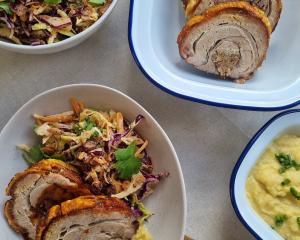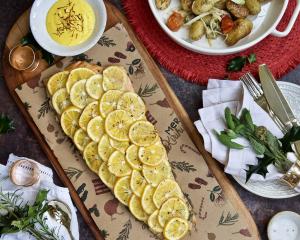A passion for zero waste and a job ending combined to provide expat New Zealander Kylee Newton a surprise career. Home on holiday, she tells Rebecca Fox about her journey to condiment producer and cookbook author.
It all started with a home-made Christmas present.
Kylee Newton had been working in London for more than a decade as a freelance artist, most recently working for photographer Wolfgang Tillman, when she decided to make chutney for Christmas presents.
"People seemed overwhelmed by the personal touch of the gift. It's Kiwi ingenuity, a natural thing to do.''
From Taranaki, Kaylee and her two sisters grew up producing the family meal once a week.
"So I was always going through cookbooks. I've always had an interest in food and am a very natural food combiner. My husband says I have a good palate.''
So when Tillman headed back to Germany and Kylee found herself without the job she loved, she thought she would make some more chutneys to sell at the local market.
Unlike in New Zealand, it is possible in England to make food goods for sale from your home.
"It makes it so much easier to start a home business.''
Kylee said the real reason to go on the preserving path was her "hate'' of wastage.
Making cakes or pastries was already pretty popular but would have created waste when you had to throw out what you didn't sell, she said.
"Preserving is the perfect ideology to appease my sensibility about not wasting.
"I can use up the seasonal glut and give it a new life. It seemed perfect to make.''
She was a self-taught preserver, learning the ropes to make chutneys and jams in her home kitchen.
A fine arts graduate, she always thought she wanted to be a famous artist.
"What I do with food is a much more creative outlet, gentler. The art world was daunting, scary to me, whereas the food world is warm. Everyone relates to food.''
She decided she wanted her products, named Newton and Pott, to have some New Zealand "flair'' and evoke memories of a Kiwi childhood, so she chose popular New Zealand flavours such as feijoas and tamarillos and sold them at the nearby East London Broadway market in Hackney.
"I'm a familiar face as a resident. There is a nice community feel in such a big city that I crave.''
Londoners, given their diversity, had a curious palate and liked trying different flavour combinations.
At the market she gave customers tasters to try.
"The best seller is the tamarillo and feijoa chutney. I have a cult expat following.''
That was two to three years ago and since then the popularity of home-made goods, markets and knowing what is in your food has grown.
"It was the right thing at the right time.''
She had been making the products - about 2000 jars - in her own tiny home kitchen right up until Christmas, when she took the plunge to lease out kitchen space.
"It's been manic. My poor husband has put up with a lot, clothes that smell like chutney. So enough was enough.''
When Penguin and Random House's re-print of an old preserving book flew off the shelves they began to look for a modern take on the craft.
"I got this email asking if I wanted to write a book. I was like thinking it was something I could do five years down the track.''
But she took up the offer and spent the past 18 months writing the cookbook.
"The response has been lovely. It is lovely getting emails from people who have been making stuff from it.''
Anyone could take up preserving and make it part of their lives.
They did not need a huge amount of equipment, an amazing garden or a huge kitchen, she said.
"If you saw my kitchen it would surprise you.''
Ask your nearby grocery shop if they have any fruit going to waste that they cannot sell.
"That fruit can be made into chutneys, although for jams you need younger fruit.''
Two-tone peach and blackberry jam
Makes 6-8 228ml jars
This recipe is a bit of fun: two jams for the price of one. It looks amazing and gets a lot of attention on the Newton & Pott market stall. You could actually do this with most of the recipes that have a medium set as they will happily sit on top of each other without mixing together.
Peach jam
1kg peaches
500g jam sugar
40ml lemon juice (juice of about ½ lemon)
Blackberry jam
1.6kg blackberries
200ml water
1kg jam sugar
30ml lemon juice (juice of about ½ lemon)
Method
The peaches need peeling for this recipe.
Do this by cutting a cross on their base, blanching them in boiling water for a couple of minutes, then dunking them in ice-cold water.
The skins will peel off easily.
Make sure you start the peach jam first as it takes longer and, while it's cooking, prepare the blackberry jam.
That way the jars won't cool too much before you pour in the second jam.
Peel, stone and dice the peaches.
Combine all the peach jam ingredients together in a large jam pan and boil, stirring often, for 30 to 40 minutes.
Use the wrinkle test to check the setting point then, when ready, take off the heat and skim off any scum from the surface.
Meanwhile, place the blackberries in a separate large jam pan with the water and slowly soften on a moderate heat for about 10 minutes.
Add the jam sugar, stir to dissolve then bring to the boil for about 15 to 20 minutes, stirring intermittently.
Use the wrinkle test to check the setting point then, when ready, take off the heat and skim off any scum from the surface.
Mark a halfway line on the warm, dry sterilised jars and pour in the blackberry jam to fill up to this line.
Let it sit for 5 minutes while it forms a seal and you finish the other jam.
Once the peach jam is ready, pour it on top of the blackberry jam to fill the jars almost to the rim and seal.
Season
Late summer to early autumn
How to eat
With toast, and use a long-handled spoon to get the jams out of the jar, to make sure you get the best of both flavours!
Keep unopened for up to 6 months.
Once opened, refrigerate and eat within four to six weeks.
Tomato kasundi
Makes 5-6 350ml jars
This is the best tomato chutney. It comes from India and is full of lots of wonderful Indian spices, which give it a fiery heat. Though very simple to make, it is super-versatile and matches beautifully with many dishes.
Ingredients
1.5kg tomatoes
2½ tsp salt
9 garlic cloves
180g fresh ginger
1 tsp coriander seeds
10 birds-eye chillies
260g onions
350g apples
350ml cider vinegar
2 tbsp black mustard seeds
50ml olive oil
1 tbsp cumin seeds
1 tbsp ground turmeric
2½ tbsp nigella seeds
½ tsp whole cloves
1 tsp chilli powder
200g dark brown sugar
Method
Measure and prep all the ingredients first, to make it easier and faster to cook.
Roughly chop the tomatoes, stir in the salt and leave to steep for about an hour. Meanwhile, prep all the other ingredients: peel and chop the garlic and ginger, crush the coriander seeds, finely chop the chillies, peel and finely dice the onions and peel, core and chop the apples into 1cm cubes.
Warm the vinegar on a low heat in a small saucepan, add the mustard seeds, then remove from the heat and leave to infuse for 15 minutes.
Put the garlic and ginger into a blender and pulse a few times. Add the vinegar and mustard seed infusion and blend into a smooth paste.
Heat the oil in a large, heavy-bottomed saucepan on a high heat for 1 minute. Take off the heat for a moment then add the crushed coriander seeds, cumin seeds, turmeric, nigella seeds, cloves and chilli powder. Fry on a moderate heat for 20 seconds then add the mustard-vinegar paste and the chillies and onions. Fry for a further 5 to 10 minutes.
Drain the excess liquid from the tomatoes and add to the pan with the apples and sugar.
Reduce the heat and simmer gently for an hour, stirring occasionally.
Ladle into warm, dry sterilised jars and seal.
Can be eaten immediately but also great if left to mature in a cool, dark place for four weeks if you can.
How to eat
Lovely with samosas, curries or rice dishes. Or straight out of the jar on naan breadKeeps for up to a year unopened. Once opened, refrigerate and eat within four months.












